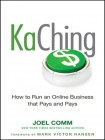KaChing: How to Run an Online Business that Pays and Pays Comm, Joel (books for 8th graders txt) 📖

Book online «KaChing: How to Run an Online Business that Pays and Pays Comm, Joel (books for 8th graders txt) 📖». Author Comm, Joel
Now that there is a lot more on the Web, those sites aren’t making money. The sites that are making money are the ones that follow the formulas that work.
In this chapter, I describe a number of web sites that make great models for entrepreneurs. Now I don’t know whether these sites are making a lot of money. I know that some are making some money; I suspect that others are making giant piles of money; and it’s likely that still others could be making a lot of money if they really wanted to. But perhaps that’s not the main reason they were created. How much these sites are actually making isn’t important. What is important is how much you could be making if you follow the models shown on these pages.
Content Sites
All web sites rely on good content. That’s true whether their goal is simply to attract readers and have fun or to make money for the site’s publisher. In this section, I look at a number of sites that offer great content and surround that content with a range of different types of revenue channels.
TRAVELS WITH SHEILA
I’m going to start these case studies with a site I know well. TravelsWithSheila.com (www.travelswithsheila.com) is my mom’s web site (Figure 8.1). It’s also a great example of how anyone—and I really do mean anyone—can create multiple revenue streams online based on the knowledge that they’ve built up indulging their passion.
My mom is nuts about travel. She’s been everywhere, and she’s always on the move. I don’t think there’s a country she hasn’t been to, an airline she hasn’t flown, or some personal belonging she hasn’t left in a hotel room somewhere. During those travels, she’s built up a huge bank of knowledge. She can tell you how to find archaeological digs in Israel, trek safely in Kashmir, and feed the penguins in Patagonia. She can also tell you which travel companies have the best bargains, how to pack smartly, and why “dynamic conversion” always costs you more when picking up the bill in a foreign restaurant. When it comes to travel, she’s a gold mine of information.
When it comes to computers though, she’s never really been ahead of the curve. It took me quite a while to persuade her that sharing her travel knowledge and stories online could generate enough money to help pay for those constant round-the-world trips. Since launching TravelsWithSheila.com, she’s come to appreciate that all the time I spent playing with the computer when I should have been doing my homework actually gave me a great education. That’s priceless.
Figure 8.1Home page of my mom’s site TravelsWithSheila.com. Note how the first thing that hits you is the AdSense ads. That’s smart positioning! She also has a search box and a newsletter field for capturing e-mail addresses, all above the fold.
The first thing that strikes you when you reach the site is two AdSense units. They dominate the above-the-fold content area. In fact, of the real content, you can see only the headline and a few lines of the first article beneath those AdSense units. The pictures running down the side of the page, which look like vacation snapshots, help to frame those ads so that they blend into the page, but it’s the ads that are front and center. This site is designed to make money (Figure 8.2).
There are more AdSense units in the articles themselves. Each page has a horizontal text unit immediately below the headline, a placement that makes the ads look like navigation links. Another square unit is embedded right at the beginning of the article, and there’s usually another one at the end to catch readers once they’ve finished reading and before they click away.
Figure 8.2In this article, my mom talks about finding travel bargains, and she works an affiliate link into the text. You can also see a Kontera ad, a link to her telephone coaching, her train guide information product, and the adventure finder widget that pays on an affiliate basis. It′s good content packed with subtle, moneymaking channels.
But AdSense isn’t the only method that the site uses to monetize readers. The text also contains Kontera ads, and in the left column there’s an interactive tool that lets readers find quotes for their next adventure vacation. That’s an affiliate widget. Above it is a link to an information product, a 17-page guide that my mom wrote about European train travel. Readers can download it for seven bucks. And above that is a small ad that links to my mom’s travel coaching service. For $47, she’s available for half-hour phone consultations. (Buyers also receive the e-book and a subscription to her weekly newsletter.)
There’s revenue from AdSense units. There’s revenue from Kontera. There’s revenue from affiliate links. There’s revenue from an information product. And there’s revenue from some simple and occasional coaching.
It’s all based on content—nothing more than short articles—and the specific knowledge that those articles contain. That’s vital. My mom tells great stories. She has lots of information to share, and the people who read her blog are both entertained and informed. AdSense, Kontera, her e-book, and the other tools that she places on her site give my mom a number of different ways to cash in on those stories and her expertise.
It’s all very simple. There’s nothing technically challenging about the site—my mom really isn’t the technical type. It’s just good content monetized with the Web’s proven monetization tools. You can think of it as an example of a mom-and-pop commercial web site.
READWRITEWEB
TravelsWithSheila.com is a one-person web site that uses good content and a variety of





Comments (0)